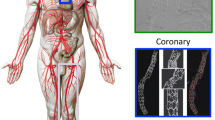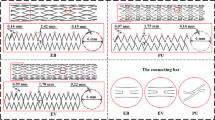Abstract
A computational and experimental method on biomechanics of stent is presented to analyze the stress distribution of different phases and evaluate the fatigue life according to Goodman criteria. As a result, the maximum stress and alternating stress were always located at the curvature area of rings, the fatigue bands in the experiment also verified the computation rationality. Matching between the numerical simulation and experimental results was satisfactory, which proved that the finite element analysis could provide theoretical evidence and help design and optimize the stent structure.
Similar content being viewed by others
References
Sasaki Y, Hwang MW, Shirasawa K, Takeda S, Ayukawa H, Inenaga-Kitaura K, Takeoka R, Kitaura Y, Kawai C (2008) Stenting for superficial femoral artery atherosclerotic occlusion: long-term follow-up results. Heart Vessels 23(4):264–270
Tanaka S, Watanabe S, Matsuo H, Segawa T, Iwama M, Hirose T, Takahashi H, Ono Y, Warita S, Kojima T, Minatoguchi S, Fujiwara H (2008). Prospective randomized trial comparing a nitinol self-expanding coronary stent with low-pressure dilatation and a high-pressure balloon expandable bare metal stent. Heart Vessels 23(1):1–8
Omurlu K, Ozeke O (2008) Side-by-side false and true lumen stenting for recanalization of the chronically occluded right coronary artery. Heart Vessels 23(4):282–285
Serruys PW, Kutryk MJB, Ong ATL (2006) Coronary-artery stents. N Engl J Med 354(5):483–495
Morice MC, Serruys PW, Sousa JE, Fajadet J, Ban Hayashi E, Perin M, Colombo A, Schuler G, Barragan P, Guagliumi G, Molnar F, Falotico R (2002) A randomized comparison of a sirolimuseluting stent with a standard stent for coronary revascularization. N Engl J Med 346(23):1773–1780
British Standard: BS EN 14299 (2004) Non active surgical implantsparticular requirements for cardiac and vascular implants-specific requirements for arterial stents. 12 pp
US Food and Drug Administration (2005) The guidance for industry and FDA staff: non-clinical tests and recommended labeling for intravascular stents and associated delivery systems. pp 14–19
Migliavacca F, Petrini L, Montanari V, Quagliana I, Auricchio F, Dubini G (2005) A predictive study of the mechanical behaviour of coronary stents by computer modeling. Med Eng Phys 27(1):13–18
De Beule M, Van Impe R, Verhegghe B, Segers P, Verdonck P (2006).Finite element analysis and stent design: Reduction of dogboning. Technol Health Care 14(4-5):233–241
Takashima K, Kitou T, Mori K, Ikeuchi K (2007) Simulation and experimental observation of contact conditions between stents and artery models. Med Eng Phys 29(3):326–335
Dehlaghi V, Shadpoor MT, Najarian S (2008) Analysis of wall shear stress in stented coronary artery using 3D computational fluid dynamics modeling. J Mater Process Technol 197(1-3): 174–181
Holzapfel GA, Stadler M, Gasser TC (2005) Changes in the mechanical environment of stenotic arteries during interaction with stents: computational assessment of parametric stent designs. J Biomech Eng 127(1):166–180
Chua SND, Macdonald BJ, Hashmi MSJ (2004) Finite-element simulation of slotted tube (stent) with the presence of plaque and artery by balloon expansion. J Mater Process Technol 155–156: 1772–1779
Chua SND, Macdonald BJ, Hashmi MSJ (2004) Effects of varying slotted tube (stent) geometry on its expansion behaviour using finite element method. J Mater Process Technol 155-156: 1764–1771
Gervaso F, Capelli C, Petrini L, Lattanzio S, Di Virgilio L, Migliavacca F (2008) On the effects of different strategies in modelling balloon-expandable stenting by means of finite element method. J Biomech 41(6):1206–1212
De Beule M, Mortier P, Carlier SG, Verhegghe B, Van Impe R, Verdonck P (2008) Realistic finite element-based stent design: The impact of balloon folding. J Biomech 41(2):383–389
Dumoulin C, Cochelin B (2000) Mechanical behaviour modelling of balloon-expandable stents. J Biomech 33:1461–1470
Lau KW, Sigwart U (1991) Intracoronary stents. Indian Heart J 43:127–139
Author information
Authors and Affiliations
Corresponding author
Rights and permissions
About this article
Cite this article
Li, J., Luo, Q., Xie, Z. et al. Fatigue life analysis and experimental verification of coronary stent. Heart Vessels 25, 333–337 (2010). https://doi.org/10.1007/s00380-009-1203-9
Received:
Accepted:
Published:
Issue Date:
DOI: https://doi.org/10.1007/s00380-009-1203-9




